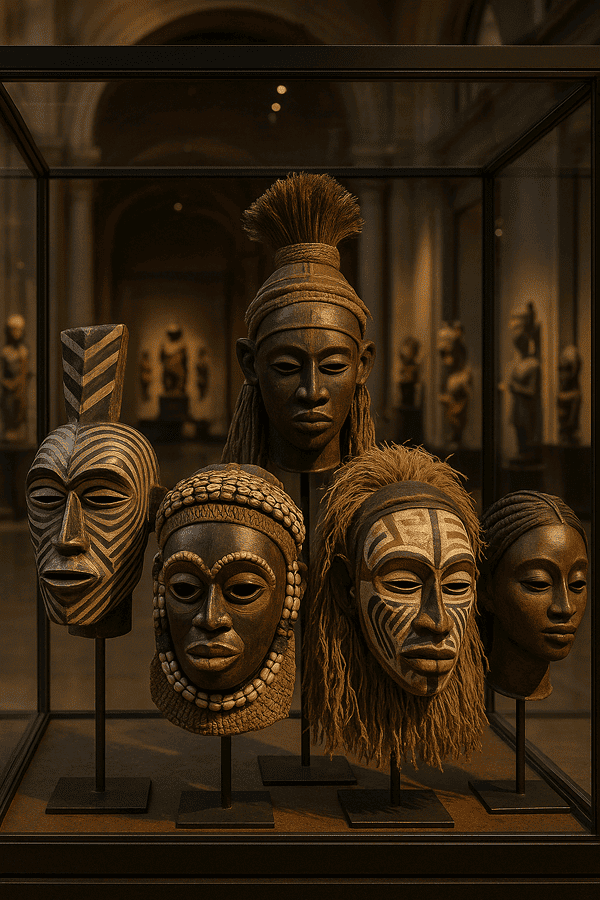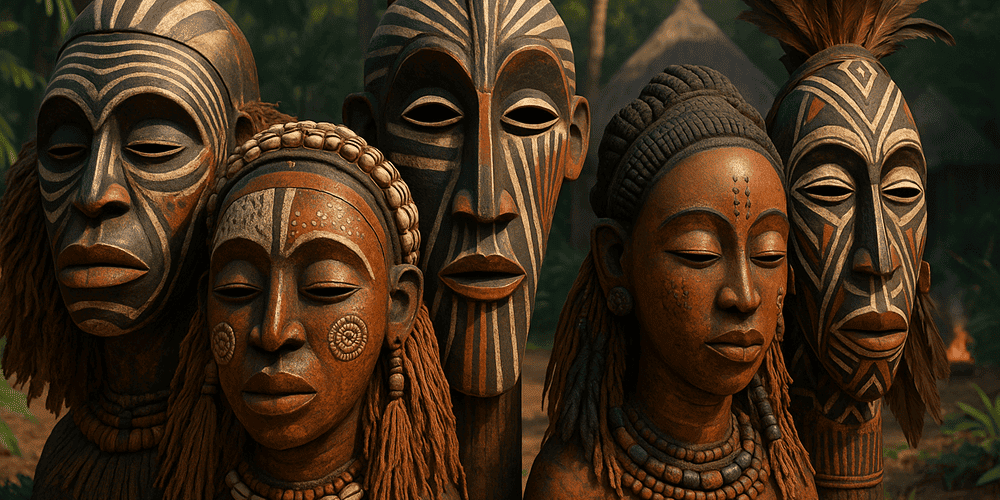Congolese Masks are among Africa’s most renowned ritual and artistic objects, celebrated for their diversity, expressive power, and deep spiritual meaning. Originating from the vast and ethnically diverse Congo Basin — encompassing the modern Democratic Republic of Congo and Republic of Congo — these masks are central to the tradition of many groups, including the Kuba, Pende, Chokwe, Songye, Luba, and Yaka peoples. Congolese Masks are instantly recognizable for their striking forms: elongated faces, bold geometric designs, dramatic protruding features, and vibrant use of color, raffia, beads, shells, and pigments. Whether rendered in wood, fiber, or metal, these masks often display symbolic scarification marks, stylized eyes, and elaborate coiffures. Most are used in ritual and performance, serving as powerful conduits between the human and spiritual worlds. The tradition has existed for centuries and continues to play a vital role in both local culture and the global appreciation of African art.
Historical Origins of Congolese Masks
The origin of Congolese Masks is deeply rooted in the precolonial history of Central Africa. The term “mask” in the region is translated into numerous local languages, such as “mukishi” (Kikongo), “nganga” (Kuba), or “kifwebe” (Songye/Luba), often indicating both the object and the spirit or role it represents. Early masks likely arose from animistic practices, ancestor worship, and the need for ritual mediation in community life. Archaeological evidence and oral histories reveal that by the 15th century, elaborate mask traditions were well established, used in royal courts, initiation rites, funerals, healing ceremonies, and social justice rituals. Over time, the design and function of masks evolved — absorbing influences from interethnic trade, migration, and colonization. Masks became more specialized, with each ethnic group developing unique forms, styles, and ceremonial uses. Notable historical references include the use of Kuba royal masks in enthronement rituals and the Songye “kifwebe” masks in secret society performances. The legacy of Congolese mask artistry is comparable to other African traditions, such as South African Masks, which share themes of ancestor veneration and communal identity.
Cultural Significance and Symbolism of Congolese Masks
Congolese Masks are imbued with rich symbolic meaning, functioning as mediators between the physical and spiritual realms. In many cultures, masks are believed to be inhabited by spirits, ancestors, or mythical beings during ceremonies, granting the wearer supernatural power or authority. Common themes include fertility, protection, transformation, and the cyclical nature of life. For example, Songye “kifwebe” masks are used in male and female variants to represent different cosmic forces: striated male masks evoke order and discipline, while rounder female masks symbolize fertility and protection. Kuba royal masks signify kingship and the continuity of the state, while Pende masks may depict ancestral spirits, tricksters, or social archetypes. Myths and oral traditions often explain the origin of specific masks, their powers, and their role in maintaining social harmony. Socially, the use of masks reinforces community bonds, marks important life transitions, and transmits cultural knowledge through dance, music, and storytelling.

Materials and Craft Techniques of Congolese Masks
Traditional Congolese Masks are crafted from a variety of materials, primarily hardwoods such as wenge, mahogany, or ebony, selected for their durability and spiritual significance. Artisans use adzes, knives, and chisels to carve the basic form, then smooth and polish the surface. Masks are often adorned with natural pigments, kaolin clay (for white coloration), ochre, charcoal, and plant dyes. Decorative elements such as raffia fiber, animal skins, beads, cowrie shells, feathers, and metal embellishments are added to enhance the mask’s symbolic and visual impact. Techniques such as scarification (incised lines), inlay, and attached coiffures are used to reference status, beauty, or spiritual power. Regional differences are pronounced: Kuba masks are known for their geometric patterns and beaded surfaces, Pende masks for their expressive faces and movable jaws, Songye “kifwebe” masks for their striated surfaces and dynamic shapes. The color palette is highly symbolic — white for purity or the ancestral realm, red for vitality and life force, black for mystery or the unknown, and blue for the supernatural.
Functions and Uses of Congolese Masks
The primary function of Congolese Masks is ritual and ceremonial. Masks are worn during initiation rites, funerals, healing ceremonies, harvest festivals, and judicial proceedings. They are essential to the activities of secret societies, royal courts, and village rituals, where they are believed to embody spirits, ancestors, or cosmic forces. Theatrically, masks animate dance-dramas that communicate social values, historical events, or mythological tales. In some communities, masks are used to enforce social norms, mediate disputes, or ensure the fertility of land and people. Over time, the use and meaning of masks have adapted to new contexts, including Christian festivals, national celebrations, and tourist performances. Today, Congolese Masks are also displayed in museums, featured in art exhibitions, and incorporated into contemporary artistic practice, highlighting their enduring relevance and adaptability.
Regional Variations of Congolese Masks
The Congo Basin is home to a dazzling array of mask traditions, each shaped by local beliefs, materials, and aesthetics. Kuba masks are famous for their beaded surfaces, geometric abstraction, and connection to royal ritual. Pende masks are notable for their bold facial features, use of raffia wigs, and roles in initiation and healing. Chokwe masks, such as the “mwana pwo” (young woman), embody ideals of female beauty and social harmony. Songye “kifwebe” masks are highly stylized, with striated surfaces and often protruding, square mouths. Yaka and Suku masks are known for their comic or grotesque expressions and vibrant colors. Each group’s masks reflect unique mythologies and social structures, yet all share the goal of connecting the community to the spiritual world. Compared to other African mask traditions, Congolese Masks are especially celebrated for their innovation in form, material, and performance.
Famous Examples and Collections of Congolese Masks
Some of the world’s most famous Congolese Masks are held in museums and private collections across Africa, Europe, and the Americas. The Royal Museum for Central Africa (Tervuren, Belgium), Musée du Quai Branly (Paris), British Museum (London), and Smithsonian National Museum of African Art (Washington, D.C.) all feature outstanding collections. Notable examples include the Kuba “Bwoom” and “Moshambwooy” masks, Songye “kifwebe” masks, and Chokwe “mwana pwo” masks. Important archaeological finds and historic artifacts are preserved in national museums in Kinshasa and Brazzaville. Private collectors and online resources like toddmasks.com offer virtual galleries, expert commentary, and educational materials, making these treasures accessible to a global audience.

Influence of Congolese Masks on Art and Culture
Congolese Masks have had a profound influence on both African and global artistic traditions. Their bold forms and symbolic meanings inspired 20th-century modernists such as Pablo Picasso and Henri Matisse, influencing the development of Cubism and abstract art. In literature, music, and theater, Congolese Masks appear as powerful symbols of identity, resistance, and transformation. Contemporary African artists continue to reinterpret mask motifs in painting, sculpture, performance, and fashion, bridging tradition and innovation. The ongoing presence of Congolese Masks in festivals, public art, and museum exhibitions ensures their role in preserving cultural memory and fostering creativity. Their influence can also be seen in modern design, architecture, and jewelry, underscoring the enduring relevance of mask culture.
Contemporary Status and Preservation of Congolese Mask Traditions
Today, the tradition of Congolese Mask making and performance faces both challenges and opportunities. Urbanization, globalization, and religious change have led to the decline of some practices, but many communities and master carvers actively sustain and adapt their traditions. Workshops, apprenticeships, and cultural festivals support the transmission of skills and knowledge. Museums and educational programs promote awareness and appreciation, while contemporary artists develop new interpretations using traditional and modern materials. Digital resources — such as toddmasks.com — play a vital role in documentation, research, and public engagement. Innovations in style, material, and performance ensure that Congolese Masks remain a vibrant and evolving expression of African cultural heritage.
Collecting and Acquiring Congolese Masks
The market for Congolese Masks includes authentic ceremonial pieces, antique artifacts, and contemporary creations. Masks are available from artisan studios, galleries, auctions, and online platforms. Prices vary widely depending on age, craftsmanship, provenance, and rarity. Collectors are advised to seek expert authentication, respect local and international laws, and prioritize ethical sources that support artists and communities. Toddmasks.com offers advice on identifying genuine masks, understanding their significance, and practicing responsible collecting. Ethical considerations are crucial, as many masks are considered sacred, and their acquisition should respect the cultural and spiritual values of their origin.
